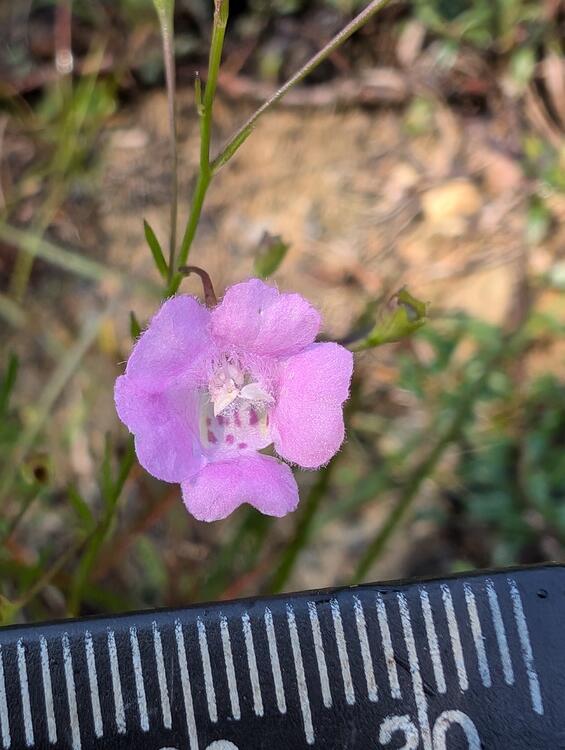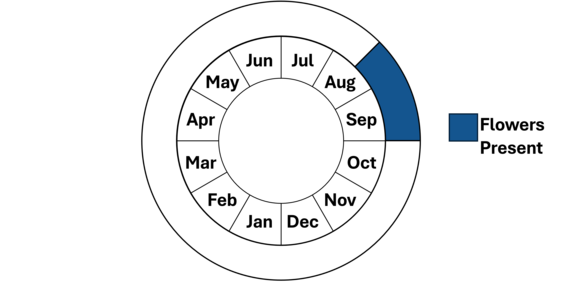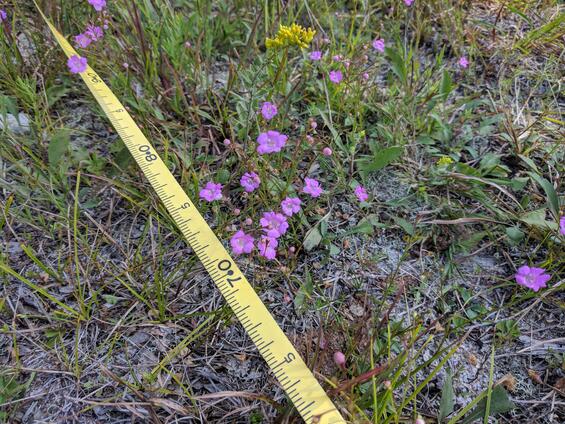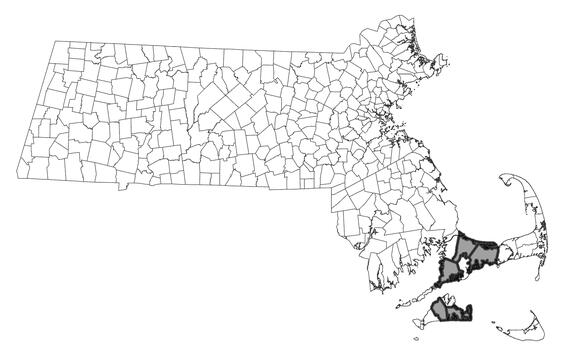- Scientific name: Agalinis acuta Pennell
- Synonyms: Agalinis decemloba (Greene) Pennell
- Species of Greatest Conservation Need (MA State Wildlife Action Plan)
- Endangered (MA Endangered Species Act)
- Endangered (US Endangered Species Act)
Description

Sandplain gerardia. Photo credit: Robert Wernerehl
Agalinis acuta is a delicate, sparsely branched, light yellowish-green annual plant in the broom-rape family (Orobanchaceae). Although it may occasionally grow up to 40 cm (15.7 in) tall, it usually grows from 10-20 cm (4-8 in) high. The stem is smooth and slender, and the opposite, linear leaves are 0.5-1 mm (0.02-0.04 in) wide and 10-25 mm (0.4-1 in) long. The flower stalks are 10-30 mm (0.4-1.2 in) long, one to three times the length of the subtending leaf-like bracts. Sandplain gerardia’s rather bell-shaped flowers are arranged in a terminal raceme (a cluster of stalked flowers on an elongate, unbranched axis) and also in shorter lateral racemes. The blossoms are pink-purple, with two cream-colored lines. The corolla tube (cylindrical structure formed by the fusion of petals) is 7-9 mm (0.28-0.35 in) long and ends in 3-4 mm (0.12-0.16 in) long lobes that are either shallowly notched or square at their tips. The white throat (opening at the summit of the corolla tube) is marked with purple spots. Flowering season is from late August through late September, and individual blossoms last for only a day. Sandplain gerardia’s fruits are ovoid capsules (fruits that are derived from a compound pistil and that contain many seeds). The tiny, yellow-brown seeds are covered with a net-like pattern.
Three other species of the genus Agalinis may also occur in fields. Purple gerardia (Agalinis purpurea) and small-flowered gerardia (A. paupercula) normally occupy wet pond shores, meadows, and seasonally wet power line rights-of-way. Their flowers are much larger than those of sandplain gerardia, the petals are rounded, and the pedicels (flower stalks) are much shorter than the subtending leaf-like bracts (sandplain gerardia’s corolla lobes are notched or squared-off, and its pedicels are at least as long as the bracts). Slender gerardia (A. tenuifolia) usually occurs on dry, rocky slopes, but it occasionally grows on sandy fields as well. Nevertheless, the petals of this small, many-branched, bushy plant are rounded, and the pedicels vary from only one-half as long to as long as the subtending bracts.
Life cycle and behavior
Agalinis acuta is an annual species that grows from seed every year. Although a green plant, sandplain gerardia does not survive by itself; it is a hemiparasite on other plants, including little bluestem. After germination, its roots attach to those of a host plant in order to obtain some of its nutrients and moisture.

Blooms August 15th through all of September. Seed capsules remain on the plant through November. The plant is really barely recognizable before flowering.
Population status
In 1988, sandplain gerardia was given Endangered status by the federal government. As of 2024, there were fewer than twenty-three extant populations worldwide, including 11 in Massachusetts, of which 5 are reintroductions from seed. The plant is also listed under the Massachusetts Endangered Species Act as Endangered. All state-listed species are protected from killing, collecting, possessing, or sale and from activities that would destroy habitat and thus directly or indirectly cause mortality or disrupt critic al behaviors. It is currently known from Barnstable, Dukes, and Plymouth Counties and is historically known from Barnstable, Bristol, Dukes, Middlesex, Nantucket, and Worcester Counties. Sandplain gerardia is considered globally imperiled, and is very rare and in danger of extinction throughout its range.

Photo credit: Robert Wernerehl
Distribution and abundance
Sandplain gerardia has a very restricted distribution. The maximum documented range includes only Massachusetts, Connecticut, Rhode Island, New York, and Maryland. Massachusetts has the largest known populations of this species in the world.

Distribution in Massachusetts
1999-2024
Based on records in the Natural Heritage Database
Habitat
Sandplain gerardia grows in dry, sandy soils of grasslands and roadsides; in pine/oak scrub openings, usually where there is considerable growth of lichens and scattered patches of bare soil; and in sandy plains. Both poor soils and habitat disturbance may create the open, relatively competition-free areas required by sandplain gerardia. Habitats in Massachusetts are dry grasslands, including cemeteries with native species maintained by early season mowing. Associated plant species include little bluestem (Schizachyrium scoparium), pussytoes (Antennaria neglecta), bearberry (Arctostaphylos uva-ursi), poverty oatgrass (Danthonia spicata), early low blueberry (Vaccinium angustifolium), red fescue (Festuca rubra), stiff aster (Ionactis linariifolia, formerly Aster linariifolius), pinweed species (Lechea spp.) and bird's foot violet (Viola pedata). Bushy rockrose (Crocanthemum dumosum, formerly Helianthemum dumosum) is a rare Massachusetts plant that has been found with sandplain gerardia.
Healthy habitats are vital for supporting native wildlife and plants. Explore habitats and learn about conservation and restoration in Massachusetts.
Threats
It is believed that the species' decline is due to habitat loss resulting from vegetational succession, fire suppression, and land development. Periodic disturbances through prescribed fire, mowing, or grazing are important for maintaining the open grassland habitat. Annual mowing (after seed dispersal) has maintained open, short, grassy habitat at several sites. Sandplain gerardia is an annual and may have great variation in its numbers from year to year. Some populations are located within 100 meters (330 ft) of the ocean and are threatened by sea level rise which is expected to impact the area (Staudinger et al. 2024).
Conservation
Survey and monitoring
MassWildlife’s Natural Heritage Endangered Species Program (NHESP) has been conducting annual counts on populations for the last two decades. Numbers vary widely and seem to be in response to climate fluctuations and land management, especially fire history. The plant needs annual counts in order to assess populations. One new population was found in 2024, so more survey work is needed and should be conducted when the plant is in flower in late August or early September. The brightly colored corolla drops off the plant in early afternoon, making morning surveys more effective and efficient. Re-surveys are needed to determine how late in the year the plant holds its seed capsules.
Management
Mowing of sites should cease by July 1 at the latest, and ideally by June 15. Prescribed fire is a valuable tool and should be used frequently but is not thought to be needed every year.
Research needs
Further research is needed as to which species are host plants for the hemiparasitic behavior and to determine be late season management. On sites where prescribed fire is used, more research on best fire-return intervals is needed.
References
Cullina, M., B. Connolly, B. Sorrie, and P. Somers. 2011. The vascular plants of Massachusetts: a county checklist, 1st revision. Massachusetts Natural Heritage & Endangered Species. Massachusetts Division of Fisheries and Wildlife, Westborough, MA.
Fernald, M. L. 1950. Gray’s Manual of Botany, Eighth (Centennial) Edition—Illustrated. Eighth. American Book Company, New York.
Gleason, Henry A., and Arthur Cronquist. Manual of Vascular Plants of Northeastern United States and Adjacent Canada, Second Edition. Bronx, NY: The New York Botanical Garden, 1991.
Native Plant Trust. 2025. Go Botany website. https://gobotany.nativeplanttrust.org/ Accessed 3/21/2025
Haines, Arthur. Flora Novae Angliae. New England Wild Flower Society, Yale University Press, New Haven, CT. 2011.
NatureServe. 2025. NatureServe Network Biodiversity Location Data accessed through NatureServe Explorer [web application]. NatureServe, Arlington, Virginia. Available https://explorer.natureserve.org/. Accessed: 3/21/2025
Staudinger, M.D., A.V. Karmalkar, K. Terwilliger, K. Burgio, A. Lubeck, H. Higgins, T. Rice, T.L. Morelli, A. D'Amato. 2024. A regional synthesis of climate data to inform the 2025 State Wildlife Action Plans in the Northeast U.S. DOI Northeast Climate Adaptation Science Center Cooperator Report. 406 p. https://doi.org/10.21429/t352-9q86
Contact
| Date published: | March 24, 2025 |
|---|